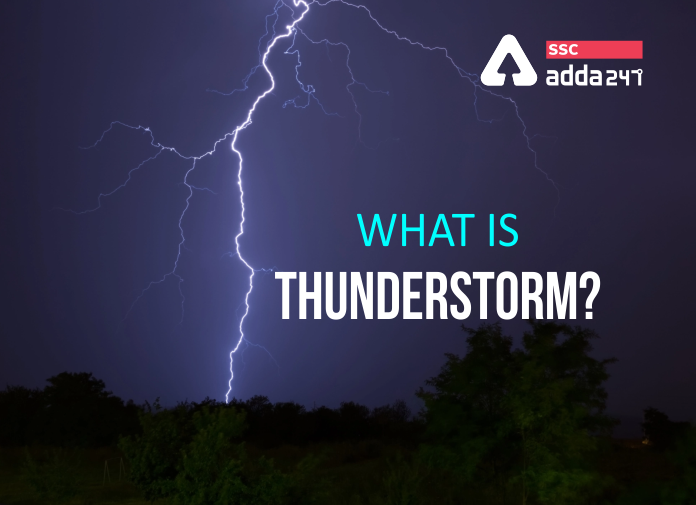Every year lightning and thunderstorms affect millions of people around the world. These are observed in areas around the world that witness extreme weather regularly. The occurrence of lightning and thunderstorms is a natural phenomenon and leads to the destruction of property, and death and can injure people. In this article let us explore various aspects of these phenomena in detail.
What is Lightning?
Lightning is an electrical discharge caused by imbalances between storm clouds and the ground, or within the clouds themselves. Most instances of lightning occur within the clouds the effects of which do not reach the surface of the earth. The most severe effects of lightning can be seen during thunderstorms. Let’s take a look at the details about Thunderstorms, types, and causes.
What is a Thunderstorm?
A thunderstorm is a short-lived weather disturbance characterized by lightning, heavy rain, thunder, strong winds, etc. Thunderstorms form when warm air rises into cold air and creates a convection cell with high wind speeds and moisture. It occurs in a type of cloud known as a cumulonimbus cloud. Severe thunderstorms result in the most dangerous and hazardous weather phenomena. Some thunderstorms can also bring tornadoes. They are most likely to occur in the months of Summer and Spring. The basic things that make a thunderstorm are moisture, unstable air, and lift.
Causes of a Thunderstorm
Thunderstorms occur in almost every region of the world. The cause of a thunderstorm can be due to the rapid upward movement of warm, moist air, to cooler regions of the atmosphere. As the moist air moves upward, it cools, condenses, and results in the formation of a cumulonimbus cloud that can reach heights of over 20 kilometers and also precipitation. The cooled air in the atmosphere strikes the ground with strong winds. Meanwhile, the electrical charges accumulate on cloud particles. When the charges become large, it results in lightning which heats the air and passes intensely producing shock waves heard as rolls of thunder.
Types of Thunderstorm
There are mainly four types of thunderstorms according to the wind conditions at different layers of the atmosphere.
- Single-cell- These are small and weak thunderstorms that die within an hour. They can be typically seen in summer and occur due to heating.
- Multi-cell clusters- These are the most common type of thunderstorms and may produce hail, strong winds, and heavy rain.
- Multicell lines/Squall Line- These thunderstorms are stronger than multicell clusters. They result in “squalls” of high wind and heavy rain.
- Supercells- These are the strongest and most severe types of thunderstorms. Most large and violent tornadoes come from this type of thunderstorm. At least 90 percent of supercells can cause severe weather-causing destruction.
Effects of Thunderstorm
A thunderstorm can be harmful if it is accompanied by lightning, gusty winds, and heavy rain. This is observed most in the case of tornadoes and cyclones. This can affect humans, animals, public properties, and even nature. Almost all of us have seen footage of damages done by these extreme weather events.
Governments around the world have specialized agencies to prepare for and deal with such events. In India, the National Disaster Management Authority (NDMA) takes care of the safety and well-being of people and resources in the areas that experience thunderstorms. Most of the thunderstorm-affected sites in India are situated on the Eastern and Western Ghats.
Where do Thunderstorms occur?
The frequency and severity of thunderstorms depend on the moisture content and temperature of the air in an area. The following factors determine the occurrence of thunderstorms in an area:
- The distance from the sea/ocean.
- The geographical features of the surrounding areas,
- Wind direction and speed in the area.
- The frequency of other phenomena like cyclones or tornadoes etc.
Safety Precautions
Ensuring the safety of the people and resources in such high-risk areas is the responsibility of not only the authorities but also the general public. In the following points we have tried to summarise the steps that anyone situated in such areas should consider taking in order to prepare for every situation regarding thunderstorms.
- Take immediate action upon hearing loud thunder. Anyone close enough to the thunderstorm can be struck by lightning.
- Avoid electrical appliances and switch them off. It may conduct electricity during thunderstorms and lightning.
- Close the windows and doors and stay away from them.
- Do not bathe or shower, during a thunderstorm as plumbing conducts electricity.
- If you are driving, safely exit the roadway, turn on hazard lights, and park. Try to remain in the vehicle and avoid touching metal.



 How can I get selected for Delhi Police ...
How can I get selected for Delhi Police ...
 SSC CHSL Vs. SSC CGL – What Changes in S...
SSC CHSL Vs. SSC CGL – What Changes in S...
 Importance of Solving Previous Year Pape...
Importance of Solving Previous Year Pape...









